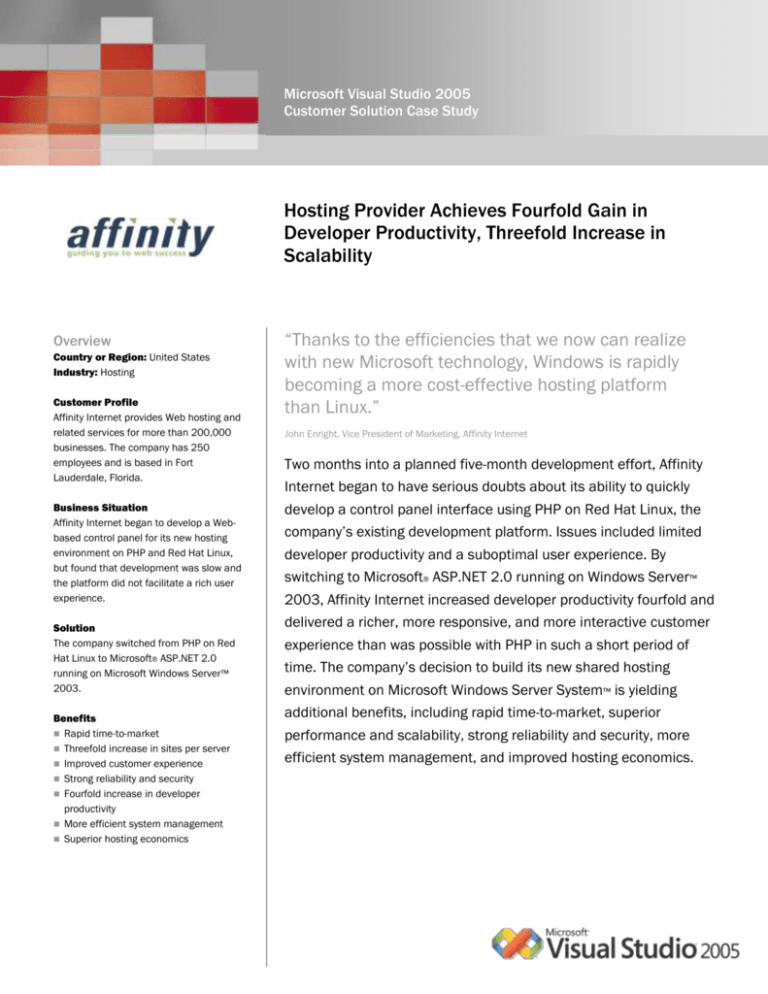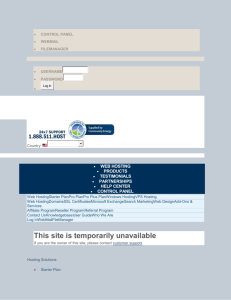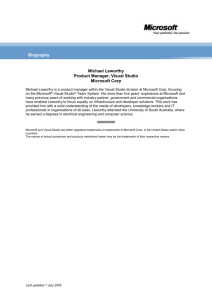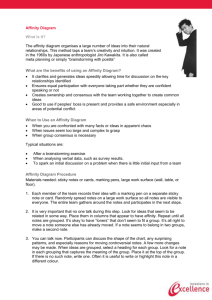
Microsoft Visual Studio 2005
Customer Solution Case Study
Hosting Provider Achieves Fourfold Gain in
Developer Productivity, Threefold Increase in
Scalability
Overview
Country or Region: United States
Industry: Hosting
Customer Profile
Affinity Internet provides Web hosting and
related services for more than 200,000
businesses. The company has 250
employees and is based in Fort
Lauderdale, Florida.
Business Situation
Affinity Internet began to develop a Webbased control panel for its new hosting
environment on PHP and Red Hat Linux,
but found that development was slow and
the platform did not facilitate a rich user
experience.
Solution
The company switched from PHP on Red
Hat Linux to Microsoft® ASP.NET 2.0
running on Microsoft Windows Server™
2003.
Benefits
Rapid time-to-market
Threefold increase in sites per server
Improved customer experience
Strong reliability and security
Fourfold increase in developer
productivity
More efficient system management
Superior hosting economics
“Thanks to the efficiencies that we now can realize
with new Microsoft technology, Windows is rapidly
becoming a more cost-effective hosting platform
than Linux.”
John Enright, Vice President of Marketing, Affinity Internet
Two months into a planned five-month development effort, Affinity
Internet began to have serious doubts about its ability to quickly
develop a control panel interface using PHP on Red Hat Linux, the
company’s existing development platform. Issues included limited
developer productivity and a suboptimal user experience. By
switching to Microsoft® ASP.NET 2.0 running on Windows Server™
2003, Affinity Internet increased developer productivity fourfold and
delivered a richer, more responsive, and more interactive customer
experience than was possible with PHP in such a short period of
time. The company’s decision to build its new shared hosting
environment on Microsoft Windows Server System™ is yielding
additional benefits, including rapid time-to-market, superior
performance and scalability, strong reliability and security, more
efficient system management, and improved hosting economics.
“By switching to
ASP.NET 2.0, we were
able to implement the
required functionality
more than twice as fast
with one-third the
resources as compared
with PHP.”
Mark Richman, Project Lead, Senior
Development Engineer, Affinity Internet
Situation
Affinity Internet provides Web-based services
for more than 200,000 business customers.
The company operates several brands,
including ValueWeb, Bigstep, HostSave, and
WinSave. In addition, Affinity “private-labels”
its services for several Fortune 100 companies, which often take advantage of their own
brand recognition and integrate the hosting
services into their existing product lines. For
both Affinity and its partners, Web hosting
provides a foundation for delivering a variety
of premium services such as Web site design,
development, and marketing.
Over the past five years, the company has
increased both server count and revenues
at an average rate of 25 percent per year.
Affinity operates 4,000 dedicated server
computers and a few hundred shared
servers, of which 30 to 40 percent run the
Windows® operating system and the rest run
various distributions of UNIX and Linux.
The Affinity brand for shared hosting on
Windows is WinSave, which was launched
in 2001, runs on the Windows 2000 Server
operating system, and does not include
access to more modern Microsoft® technologies such as the .NET Framework. Two
years ago, in response to customer demand,
Affinity began to develop a new hosting platform from the ground up. Called Gate.com,
the new offering takes advantage of the
latest Microsoft technologies and extends
their capabilities to customers.
In building Gate.com, Affinity needed to
provide characteristics similar to traditional
UNIX-based and Linux-based hosting environments, including clustered servers for high
availability and high Web site density (number of Web sites per server). “Shared hosting
is a price-sensitive business with lots of
competitors,” says William Toll, Director of
Product Management at Affinity Internet.
“Gate.com will help us differentiate ourselves
through features such as high-availability
clustering, which typically have been out of
the reach of small businesses from a cost
perspective.”
In addition to an entirely new hosting infrastructure and code for provisioning new
customers, Affinity had to develop a new
Web-based, customer-facing control panel.
The company’s existing control panel, which
was written in PHP and ran on Red Hat Linux,
was not capable of supporting the new hosting platform. Among the new requirements
were improved usability, better user interactivity, and an ability to support multiple
Affinity brands as well as rebranding by third
parties.
Because most of its development staff was
skilled on Linux, Affinity started to build the
new control panel using PHP. However, two
months into a planned five-month phase of
the project, the company began to have serious concerns about the suitability of PHP for
solution development. Six developers had
implemented only 2 of the 12 features in the
requirements specification, and even those
features were lacking in usability. “The issues
we faced with PHP included developer productivity and its failure as a platform for the
delivery of rich interactivity,” says Toll. “In
addition, PHP did not support modular
software design and was slow to execute,
which would have damaged the customer
experience.”
Solution
Affinity met its deadline for building the new
control panel and delivered a richer, more
responsive user experience by switching from
PHP on Red Hat Linux to Microsoft ASP.NET
version 2.0 running on the Microsoft
Windows Server™ 2003 operating system,
the foundation of Windows Server System™
integrated server software. In less than two
weeks, two developers working in parallel
with the PHP developers implemented a
“Automated Deployment
Services enables us to
deploy a new server in
20 minutes, with a fully
automated process
eliminating the potential
for misconfiguration.”
Matt Baldwin, Windows Systems Architect,
Affinity Internet
prototype that included all 12 features in
the requirements specification and met the
approval of the company’s Usability and
Human Factors group. The formal decision
to abandon development on PHP and move
forward with ASP.NET 2.0 came a few days
later, after a presentation to company
executives.
“I spent a few hours with one of our Windows
developers, who showed me the ASP.NET
user experience, development cycle
capabilities, flexibility, and ability to address
branding and private labels with simple
changes to the code set,” says Jon Limbird,
Chief Operating Officer for Affinity Internet. “It
was readily apparent how ASP.NET 2.0 could
help accelerate solution delivery and at the
same time deliver a higher-quality user
experience than PHP. We made the decision
to switch virtually immediately.”
Over the next six weeks, the two developers
not only finished development of the control
panel on time but also were able to go
beyond the functionality required for the beta
release of Gate.com and implement virtually
all the functionality required for its formal
launch in early 2006. Such features include
one-click installers for the free DotNetNuke
and Community Server, two popular Web
applications based on ASP.NET. Developers
also were able to add control panel elements
for features such as customized messages
for “404 error” pages which, in the past,
required users to edit text files.
“By switching to ASP.NET 2.0, we were able
to implement the required functionality more
than twice as fast with one-third the
resources as compared with PHP,” says
Mark Richman, Project Lead and Senior
Development Engineer at Affinity Internet. “In
addition, we were able to deliver the consistency, responsiveness, rich interactivity, and
standards compliance that was lacking with
PHP. With ASP.NET 2.0, we get support for
XHTML [Extensible Hypertext Markup
Language], cascading style sheets, SOAP
[Simple Object Access Protocol] 1.2, WS-I
[Web Services Interoperability], and WSDL
[Web Services Description Language], with it
all baked into the platform—capabilities that
PHP developers have to code from scratch.”
Control Panel Development
Affinity built the control panel using the
Microsoft Visual Studio® 2005 development
system, which provided an integrated tool set
for all phases of software development.
Developers used a code-behind model (in
contrast to a code-inline model, which
ASP.NET 2.0 also supports) and made
extensive use of generics—a new feature of
the Microsoft .NET Framework—to reduce the
size of the code base. Generics are programming elements with operations that can be
tailored to perform the same functions for a
variety of data types. Being able to define a
generic class or procedure eliminates the
need to define a separate version for each
data type.
Developers also used custom server (.ascx)
controls, which are loaded on the fly at run
time by placeholder controls in the Web
pages and are tightly coupled with back-end
SOAP-based provisioning Web services that
were written in the C# programming language. “With ASP.NET 2.0, we were able to
easily create custom server controls that
meet our specific business needs,” says
Richman. “Best of all, they’re reusable. We
can drag and drop existing server controls to
build new features—something you can’t do
with PHP.”
Developers also made heavy use of the new
ASP.NET 2.0 site navigation provider, which
maps the physical storage locations of
ASP.NET pages to a logical model that can be
accessed by the new navigation controls in
ASP.NET 2.0. Affinity now is looking at how it
can use the membership provider to facilitate
“With Visual Studio
2005 and ASP.NET 2.0,
we can develop new
features at least four
times as fast as we
could in a PHP
environment.”
Matt Baldwin, Windows Systems Architect,
Affinity Internet
user authentication and management, and
the personalization provider to support the
customization of Web page layouts for each
user.
written using ASP.NET 2.0. The business logic
for replication and other provisioning-related
functions is written using the C# development
language.
“By organizing site navigation logically in an
XML-based Web.sitemap file, we can adjust
Web site navigation without having to change
any code,” says Richman. “We used the site
navigation provider together with the new
SiteMapPath control to create a ‘bread crumb
trail’ user interface element that aids in site
navigation.”
Customer Web sites run in a shared environment on load-balanced clusters, each with
four servers that run Windows Server 2003
Standard Edition. The Web servers store only
the metadata for each customer, with all
content residing on—and served directly
from—a Network Appliance storage area
network.
Affinity also took advantage of ASP.NET 2.0
themes and skins, which will enable the
company to easily change the control panel’s
look and feel to support additional brands.
Themes are similar to cascading style sheets
in that they define a set of common attributes
that apply to Web pages. However, themes
differ from style sheets in that themes can
define many properties of a control or page—
not just style properties—and also can include
auxiliary files such as graphics. A skin is a set
of properties and templates that can be used
to standardize size, font, and other attributes
of controls on a page. With skins, predefined
display settings for a control can be created
and the appropriate skin applied at run time.
Internet Information Services (IIS) version
6.0, the built-in Web server in Windows
Server 2003, provides significant advantages
in such a hosting scenario. Based on a completely different design than IIS 5.0, its predecessor in Windows 2000 Server, IIS 6.0
combines a cache-enabled, kernel-mode Web
driver with a new fault-tolerant process model
to deliver significantly better performance,
scalability, manageability, and security for
Web applications and Web services.
“We plan to use the new control panel to
support some of our other brands, such as
ValueWeb,” says Richman. “Without ASP.NET
2.0 themes and skins, that would require us
to maintain two branches of code and add
new features in two places, resulting in extra
work and an increased potential for error.”
Hosting Environment
The control panel Web site resides on a cluster of two dual-processor server computers,
which run Windows Server 2003 Standard
Edition. Code-behind pages on the Web site
use SOAP 1.2 to invoke provisioning Web
services that run on a separate pair of
similarly configured servers and also were
“We could not have implemented this type of
shared, clustered hosting environment without moving from Windows 2000 Server to
Windows Server 2003,” says Matt Baldwin,
Windows Systems Architect at Affinity.
“Improvements in SMB [server message
block] and DFS [Distributed File System]
capabilities were essential, as were the
performance and scalability improvements
provided by IIS 6.0.”
Other technologies in Windows Server 2003
that play a role in the hosting environment
include:
Active Directory. The Active Directory®
directory service provides a centralized
point of administration, user authentication
for all servers, and policy management.
“We strongly believe
that the popularity of
Windows hosting
solutions among Web
designers and Web
developers, combined
with the power of
ASP.NET 2.0, will lead
to the success of our
new hosting solution.”
John Enright, Vice President of Marketing,
Affinity Internet
Automated Deployment Services.
Automated Deployment Services will help
Affinity rapidly deploy Windows Server
2003 on new servers, decreasing the time
that it takes to get a new server into a
production cluster.
Windows Server Update Services. Windows
Server Update Services provides a single
point of management for the distribution of
software updates to all servers.
In addition to Windows Server 2003, the
hosting environment takes advantage of
other Windows Server System server
products, including:
Microsoft SQL Server 2000. Customer
databases will reside on a server cluster
running Windows Server 2003 Standard
Edition and SQL Server™ 2000 Workgroup
Edition. Affinity expects a single cluster of
two dual-processor servers to accommodate roughly 700 customer databases.
Microsoft Operations Manager 2005.
Microsoft Operations Manager (MOM)
2005 will be used to monitor the health
and performance of every server in the
hosting environment. Affinity will use MOM
to automatically take predefined actions in
response to events and, in the future, to
trigger the complete rebuilding of a server
if required.
Benefits
Through the superior efficiencies provided by
the Windows platform and the ASP.NET 2.0
development environment, Affinity Internet
was able to launch its new shared hosting
solution on time, with a rich feature set, and
at an attractive price. Furthermore, capabilities provided by Windows Server System will
help Affinity easily and cost-effectively scale,
administer, and ensure the reliability of the
hosting environment as it gains popularity
with customers who require access to the
latest Microsoft technology. Moreover, many
of those same benefits will be realized by
customers who use the hosting environment.
“We strongly believe that the popularity of
Windows hosting solutions among Web
designers and Web developers, combined
with the power of ASP.NET 2.0, will lead to
the success of our new hosting solution,”
says John Enright, Vice President of
Marketing at Affinity Internet.
Rapid Time-to-Market
Due to the rich prebuilt functionality and
superior developer productivity provided by
the Windows platform, Affinity Internet was
able to build its new hosting infrastructure
and control panel in time to launch the
new brand into beta test as scheduled in
November 2005. Furthermore, the developer
productivity advantages provided by ASP.NET
2.0 helped the company surpass the planned
feature set for its beta release to include
additional features such as one-click installers for popular Web applications. And as new
Web applications are introduced by Microsoft
and other companies, Affinity can rapidly
incorporate them into Gate.com to continue
maximizing the value provided to consumers.
Superior Scalability and Performance
With Windows Server 2003 and Internet
Information Services 6.0, Affinity expects to
host 10,000 to 12,000 customer Web sites
on a four-server cluster—a threefold increase
when compared with a limit of roughly 1,000
Web sites on a single server computer running Windows 2000 Server. Furthermore,
capabilities such as Automated Deployment
Services will help the company rapidly deploy
more servers as customer demand increases.
“In the past, it took four to five hours to
deploy a new server, with a technician
following a procedure document and
manually inserting CDs,” says Baldwin.
“Automated Deployment Services enables
us to deploy a new server in 20 minutes, with
“Quality assurance
testing is showing that
execution times for
ASP.NET 2.0 are much
faster than those for
PHP, which means that
customers will benefit
from a more responsive
user experience.”
Mark Richman, Project Lead, Senior
Development Engineer, Affinity Internet
a fully automated process eliminating the
potential for misconfiguration.”
Improved Customer Experience
The functionality and flexibility provided by
the Windows platform and the ASP.NET 2.0
development environment enabled Affinity to
deliver a control panel that provides a richer
and more interactive customer experience.
For example, customers can customize “404
error” server messages without having to edit
stand-alone text files, and can easily navigate
the Web site using the “bread crumb trail”
navigation aid that Affinity developed for the
control panel using the new site navigation
provider and navigation controls provided in
ASP.NET 2.0.
Because it is precompiled, ASP.NET 2.0 also
is helping the company deliver a faster, more
responsive control panel than its PHP-based
predecessor. “Quality assurance testing is
showing that execution times for ASP.NET 2.0
are much faster than those for PHP, which
means that customers will benefit from a
more responsive user experience,” says
Richman.
Affinity shared hosting customers also will
benefit from access to the latest Microsoft
technology, as provided under the Gate.com
brand. Like the company’s own developers,
customers who are Web developers and
designers will appreciate the improvements
in developer productivity and user interactivity provided by ASP.NET 2.0, Visual
Studio 2005, and Windows Server 2003.
Strong Reliability and Security
By taking advantage of new features and
capabilities in Windows Server 2003, Affinity
was able to deliver a clustered hosting environment that will significantly improve the
reliability of customer Web sites. Similarly,
new features provided by IIS 6.0—such as its
fault-tolerant architecture and application
pools—will help the company ensure that a
single poorly behaved Web site does not
bring down other customer Web sites running
on the same server.
Security is improved through features such
as Active Directory, which provides a central
point of administration and authentication
for all servers on the network. Similarly,
Automated Deployment Services will help
ensure that new servers are properly configured when deployed, and Windows Server
Update Services will enable system administrators to rapidly and efficiently deploy software updates to address potential security
issues. Finally, Microsoft Operations Manager
will help administrators quickly identify suspicious server behavior and take the appropriate corrective actions.
High Developer Productivity
When combined, the Visual Studio 2005
development system and ASP.NET 2.0 help
Affinity realize extremely high levels of
developer productivity. Tight integration with
source control, rich designers, and integrated
debugging tools in Visual Studio allow
developers to easily take advantage of the
extensive prebuilt functionality provided by
ASP.NET 2.0 and the Windows platform,
resulting in lower development costs and fast
time-to-market for new products and product
features.
“With Visual Studio 2005 and ASP.NET 2.0,
we can develop new features at least four
times as fast as we could in a PHP environment,” says Baldwin. “Debugging is also
faster by a factor of four in that, with Visual
Studio 2005, we can easily trace through
exceptions and find the root cause of a
problem. In many cases, we can find the
problem and fix it before a trouble ticket is
opened.”
More Efficient System Management
Capabilities provided by Microsoft Operations
Manager, Automated Deployment Services,
and Active Directory will help make system
administrators more efficient, enabling
Affinity to manage its new hosting environment with minimal development and system
administration staff. In addition, the clustered
hosting environment enabled by Windows
Server 2003 will eliminate the need to call in
a technician to swap out a failed server in the
middle of the night. Instead, other servers in
the cluster will ensure uninterrupted access
to customer Web sites that were running on
the failed server until it can be swapped out
the next morning.
“Our goal is that system administrators will
never have to log on to a server,” says
Richman. “Instead, they’ll use an extended
version of the control panel to handle some
tasks and let the automated event response
capabilities of MOM handle other types of
issues.”
Superior Hosting Economics
Because of the efficiencies and scalability
that Affinity has realized, the company can
offer shared hosting on Windows at a price
that, in the past, was only achievable on
Linux. That benefit is due as much to the
usability and supportability of the Windows
platform as to hardware and software costs.
“Amortized costs for hardware and software
are about 5 percent of total costs, whereas
customer support is 20 to 25 percent of
costs,” says Toll. “By delivering a better
customer experience, as we’ve been able
to do with Windows and ASP.NET 2.0, we’ll
reduce support costs as well as attrition
rates. In the past, when one server went
down, 200 customers would call. Now, with a
clustered solution based on Windows, customers won’t even know if a server fails.”
Adds Enright, “In the past, it cost more to
provide hosting on the Windows platform
than it did on Linux. Thanks to the efficiencies that we now can realize with new
Microsoft technology, Windows is rapidly
becoming a more cost-effective hosting
platform than Linux. Microsoft understands
the needs of the hosting community and is
working to meet those needs, both through
the features of Windows as well as an
improved licensing model. In turn, we’re
better able to provide our Web developer and
small-business customers with new technology that can help them succeed.”
For More Information
Microsoft Visual Studio 2005
For more information about Microsoft
products and services, call the Microsoft
Sales Information Center at (800) 4269400. In Canada, call the Microsoft
Canada Information Centre at (877) 5682495. Customers who are deaf or hard-ofhearing can reach Microsoft text telephone
(TTY/TDD) services at (800) 892-5234 in
the United States or (905) 568-9641 in
Canada. Outside the 50 United States and
Canada, please contact your local
Microsoft subsidiary. To access information
using the World Wide Web, go to:
www.microsoft.com
Microsoft Visual Studio 2005 is the world’s
most popular development environment for
designing, developing, and testing nextgeneration Windows-based solutions and
Web applications and services. By improving
the development experience for Windows, the
Web, mobile devices, and Microsoft Office,
Visual Studio 2005 helps organizations
deliver a variety of solutions more
productively than ever before. Visual Studio
Team System expands the product line with
new software tools that enable greater
communication and collaboration throughout
the development life cycle. With Visual Studio
2005, businesses can deliver modern
service-oriented solutions more efficiently.
For more information about Affinity Internet
products and services, visit the Web site at:
www.affinity.com
For more information on Visual Studio 2005,
go to:
msdn.microsoft.com/vstudio
Acquire Visual Studio:
msdn.microsoft.com/vstudio/howtobuy
Software and Services
Microsoft Visual Studio 2005
Professional Edition
Microsoft Windows Server System
− Microsoft Windows Server 2003
Standard Edition
− Microsoft Operations Manager 2005
− Microsoft SQL Server 2000 Workgroup
Edition
© 2005 Microsoft Corporation. All rights reserved.
This case study is for informational purposes only. MICROSOFT
MAKES NO WARRANTIES, EXPRESS OR IMPLIED, IN THIS
SUMMARY.
Microsoft, Active Directory, Visual Studio, the Visual Studio logo,
Windows, Windows Server, and Windows Server System are
either registered trademarks or trademarks of Microsoft
Corporation in the United States and/or other countries. All
other trademarks are property of their respective owners.
Document published November 2005
Technologies
− Microsoft ASP.NET 2.0
− Automated Deployment Services
− Internet Information Services 6.0
− Windows Server Update Services
Hardware
Custom-built two-processor server
computers







